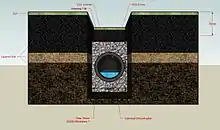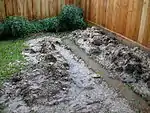French drain
A French drain[1] or weeping tile (also trench drain, filter drain, blind drain,[1] rubble drain,[1] rock drain,[1] drain tile, perimeter drain, land drain, French ditch, sub-surface drain, sub-soil drain or agricultural drain) is a trench filled with gravel or rock or containing a perforated pipe that redirects surface water and groundwater away from an area.

French drains are primarily used to prevent ground and surface water from penetrating or damaging building foundations and as an alternative to open ditches or storm sewers for streets and highways. Alternatively, French drains may be used to distribute water, such as a septic drain field at the outlet of a typical septic tank sewage treatment system. French drains are also used behind retaining walls to relieve ground water pressure.
History and construction
The earliest forms of French drains were simple ditches that were pitched from a high area to a lower one and filled with gravel. These may have been invented in France[2] but Henry Flagg French (1813–1885) of Concord, Massachusetts, a lawyer and Assistant US Treasury Secretary described and popularised them[3] in Farm Drainage (1859).[4] French's own drains were made of sections of ordinary roofing tile that were laid with a 1⁄8 in (0.32 cm) gap in between the sections to admit water. Later, specialised drain tiles were designed with perforations. To prevent clogging, the size of the gravel varied from coarse in the center to fine on the outside and was selected contingent on the gradation of the surrounding soil. The sizes of particles were critical to prevent the surrounding soil from washing into the pores, i. e., voids between the particles of gravel and thereby clogging the drain. The later development of geotextiles greatly simplified this technique.
Ditches are dug manually or by a trencher. An inclination of 1 in 100 to 1 in 200 is typical. Lining the bottom of the ditch with clay or plastic pipe increases the volume of water that can flow through the drain. Modern French drain systems are made of perforated pipe, i. e., weeping tile surrounded by sand or gravel, and geotextile or landscaping textile. Landscaping textiles prevent migration of the drainage material and also prevent soil and roots from entering and clogging the pipe. The perforated pipe provides a minor subterranean volume of storage for water, yet the prime purpose is drainage of the area along the full length of the pipe via its perforations and to discharge any surplus water at its terminus. The direction of percolation depends on the relative conditions within and without the pipe.
Subsurface drainage systems have been used commonly for centuries. They have many forms that are similar in design and function to the traditional French drain.
Drainage system structure
Variations of French drain include:
| Name | Description |
|---|---|
| Curtain drain | This form comprises a perforated pipe surrounded by gravel. It is similar to the traditional French drain, the gravel or aggregate material of which extends to the surface of the ground and is uncovered to permit collection of water, except that a curtain drain does not extend to the surface and instead is covered by soil, in which turf grass or other vegetation may be planted, so that the drain is concealed. |
| Filter drain | This form drains groundwater. |
| Collector drain | This form combines drainage of groundwater and interception of surface water or run off water, and may connect into the underground pipes so as to rapidly divert surface water; it preferably has a cleanable filter to avoid migration of surface debris to the subterranean area that would clog the pipes. |
| Interceptor drain | |
| Dispersal drain | This form distributes waste water that a septic tank emits. |
| Fin drain | This form comprises a subterranean perforated pipe from which extends perpendicularly upward along its length a thin vertical section, denominated the "fin", of aggregate material for drainage to the pipe. The length is 200 mm (7.9 in). This form is less expensive to build than a traditional French drain. |
A French drain can end, i.e., open at a downhill slope, dry well, or rain garden where plants absorb and hold the drained water. This is useful if city water systems or other wastewater areas are unavailable.
Sizing considerations

Depending on the expected level and volume of rain water or runoff, French drains can be widened or also founded on 2 or 3 underground drain pipes. Multiple pipes also provide for redundancy, in case one pipe becomes overfilled or clogged by a rupture or defect in the piping. A pipe might become overfilled if it is on a side of the drain which receives a much larger volume of water, such as one pipe being closer to an uphill slope, or closer to a roofline that drips near the French drain. When a pipe becomes overfilled, water can seep sideways into a parallel pipe, as a form of load-balancing, so that neither pipe becomes slowed by air bubbles, as might happen in a full-pipe with no upper air space.
Filters and envelopes
- Filters – Permeable materials, typically non-woven fabric, may include sand and gravel, placed around the drainage pipe or envelope to restrict migration of non-colloidal particles from the surrounding soils.
- Envelopes – Gravel, stone, rock or surrounding pipe. These are permeable materials placed around pipe or drainage products to improve flow conditions in the area immediately around the drain and for improving bedding and structural backfill conditions.
Foundation
French drains are often installed around a home foundation in two different ways:
- Buried around the foundation wall on the external side of the foundation
- Installed underneath the basement floor on the inside perimeter of the basement
In most homes, an external French drain or drain tile is installed around the foundation walls before the foundation soil is backfilled. It is laid on the bottom of the excavated area, and a layer of stone is laid on top. In many cases, a filter fabric is then laid on top of the stone to keep fine sediments and particles from entering. Once the drain is installed, the area is backfilled and the system is left alone until it clogs.[5]
While an external French drain can operate for ten years or more without the need for maintenance, it is prone to clogging without any warning and can eventually lead to a flooded basement. When there is no filter fiber, sediments can make their way through the stone as years pass and clog the drain, and when the filter fabric is present, that can instead clog with sediments. It may be wise to provide cleanouts, much as is done with sanitary sewers, to provide access for inspection with a camera snake. Also, a French drain that is not installed with a sump pump counts on gravity alone to drain foundation water, and if the house is not located on a hill or near a steep incline, finding this slope can be problematic. Additionally, maintenance on an external French drain involves expensive exterior excavation, which includes removal of walkways, shrubberies, porches, gardens, and anything else along the perimeter.
Installing a French drain around the inside perimeter is most commonly done after the house has been built. Most commonly, this is done in response to a wet basement or right before performing a basement finishing. To install this kind of drain, the perimeter of the basement floor is jackhammered down to the footing and the concrete is removed. A layer of stone is laid down, and a perforated drain pipe is laid on top of it. Water is collected from the basement wall floor joint as it enters, and a pump is installed to remove water from the house and away from the foundation.
Once completed, the area, save for a 2 in (5.1 cm) gap around the edge, is concreted over. This gap exists to allow water in from the basement walls. This can be installed very quickly—one to two days by an experienced crew. The system is easy to maintain once installed, and the sump pump will need annual maintenance to perform properly. An interior French drain is much less likely to clog than an exterior, partially due to the fact that it is not sitting underneath several feet of soil.
Interior French drain installation is an effective way to waterproof a basement but requires the use of a sump pump. Many contractors will install plastic sump pumps that can quickly break down or neglect to install a battery backup sump pump, making the basement vulnerable to flooding during power outages. Sump pumps should be installed with a battery backup system in a proper sump liner of 20 US gal (76 L) size or larger to prevent the sump from having too little water and turning on and off continuously.
French drain has evolved significantly from its origins- starting off as a hand-dug ditch, moving on to ceramic tile, PVC pipe, and eventually to the new French drain innovations on the market. Each new system is able to address weaknesses of the old as the French drain continues to improve and evolve. For example, whereas Henry French used chippings of tree bark to provide anti-microbial properties, an anti-microbial additive can now be included in the material of the plastic channel.
Legal issues
In the U.S., municipalities may require permits for building drainage systems as federal law requires water sent to storm drains to be free of certain contaminants and sediment.
In the UK, local authorities may have specific requirements for the outfall of a French drain into a ditch or watercourse.
Gallery
 Construction of a French drain for highway drainage.
Construction of a French drain for highway drainage. Beginning of French drain.
Beginning of French drain. French drain with base rock and pipe.
French drain with base rock and pipe. Top view of French drain.
Top view of French drain. A Wye-fitting joining a perforated and non-perforated corrugated pipe to a buried solid outlet
A Wye-fitting joining a perforated and non-perforated corrugated pipe to a buried solid outlet A French drain under construction after a rainfall (note that the rear end of the trench has not been dug out yet).
A French drain under construction after a rainfall (note that the rear end of the trench has not been dug out yet).
References
- "Drain Francais". 8 October 2009.
- Schultz, Bart. Guidelines on the Construction of Horizontal Subsurface Drainage Systems. New Delhi, India: International Commission on Irrigation and Drainage, 1990. Page 186.
- "What's So French About French Drains and Other Musings on Concord Agriculture". Archived from the original on 2006-09-06. Retrieved 2006-09-08.
- French, Henry F. (1859). Farm Drainage: The Principles, Processes, and Effects of Draining Land with Stones, Wood, Plows, and Open Ditches, and Especially with Tiles. New York, New York: Orange Judd and Company.
- "French Drain Services - Drainage Systems Installation and Repair". Archived from the original on 2016-10-02. Retrieved 2016-08-15.
External links
- UK Highways Agency (2001). Design Manual for Roads and Bridges, Volume 4:Drainage (Part 5: Determination of Pipe Bedding Combinations for Drainage Works) (PDF) (Publication HA 40/01 ed.). Stationery Office. p. B1–2.
- Non-residential French drains are regulated in the U.S. - US EPA
- How to Install French Drains
- What are French drains? Why are they called French drains?